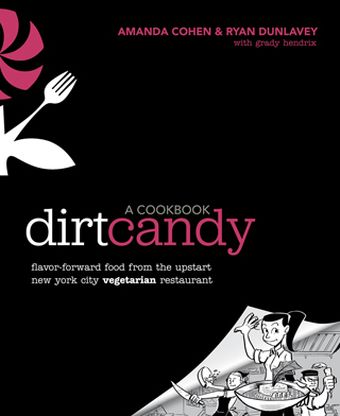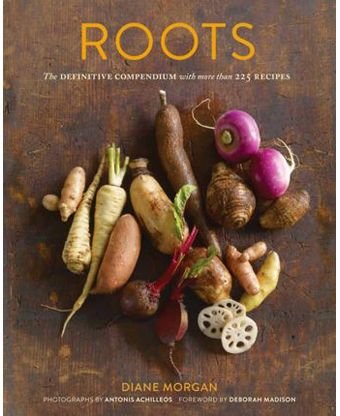My chef husband and I grow genuinely excited about our weekly visits to the farmers' market. Ours isn’t like the Union Square Market in New York or the Ferry Terminal Market in San Francisco, it’s a small, 9-stall market for our tiny island off of Seattle. (It's 15 stalls in the summer, if you count the man who makes wooden spoons or the woman who pastes old book covers onto blank journals.) The size doesn't matter. We just get excited about vegetables.
We talk fast about Japanese cucumbers in August or point excitedly at the French pumpkins our favorite farmer grows. Pumpkin curry? Pumpkin quiche?
So when we were asked to be judges for the Piglet, and were given two vegetable-centric books, we were thrilled.
Roots, by Diane Morgan, is a lavish, traditional cookbook, filled with recipes for root vegetables. That's right, root vegetables. These are the humblest, most awkward of produce. There's little that's sexy about a rutabaga. Fresh basil inspires ecstasy. Broccoli off the stem is a revelation for children. But knobbly turnips? Lotus root? Galangal? These are not the stars of the vegetable world.
Morgan, however, wants you to understand that these are the enduring stars of cuisine you should be bringing to your table. Each chapter contains a photograph of the root, an interesting introduction to it with cooking tips, storage ideas, and lists of places the vegetable is available and when. This is a book that's meant to be useful. The recipes in each section are familiar with an unexpected twist, like Pot Roast with Honey-Roasted Rutabagas. Crisp-Fried Tofu and Vegetables in Kao Saoi Coconut Broth. None of the recipes are particularly complex; most of them take up one page in the book.
The images are gorgeous, filled with strong light and beautiful dishes, but they look as though they could have been shot in someone's actual kitchen, on a wooden table near a window. Flipping through, I noticed myself bookmarking recipe after recipe. Without a doubt, I felt I could make these dishes.
Roots is a very humble book. There's little of the author in here. The headnotes aren't witty, pithy anecdotes, but rather simple evocations of the taste and texture of the dish. And really, when the recipe is for poached Asian pears with galangal and honey, I don't want any anecdotes standing between me and that dish.
This book is meant to be cooked through. What do we make with all of our sunchokes if we’ve bought too many at the market? Now, we'll pull out our copy of Roots. "Honey, how about roasted sunchokes with lemon, rosemary, and garlic? Or mixing roasted sunchokes and butternut squash in a gnocchi? Or winter greens, sunchokes, carrots, fennel, and radishes with a grainy-mustard vinaigrette?" We've made all of them now. They're all darned good.
Roots is a labor of love, a fastidious recording of every way to use every root vegetables, and an enticement to use the vegetables in a new way. It's beautifully useful.
On to Dirt Candy, a book I wanted to love. It comes from a much talked-about vegetarian restaurant in New York. It's a comic book cookbook! With kick-ass vegetarian food! There is a recipe for celery salad with grilled king oyster mushrooms and celery pesto! This book is daring, interesting, and certainly one-of-a-kind.
Since I wrote a narrative cookbook, mostly about my chef husband and what his life on the line was like, I assumed I'd choose this book to win. How could I not?
The first risk of a narrative cookbook is having a narrative that doesn't compel further reading. It takes great courage to write truthfully about how difficult it is to open and run a restaurant. (My husband Danny and I read parts of this book to each other and nodded our heads continually.) However, the narrative -- told strictly in comic-book form -- ends up being mostly the story of complaints about contractors, customers who don't understand the food, and the complications of being on Iron Chef.
The food in Dirt Candy is truly exciting. Smoked Corn Dumplings. Wasabi Pea Leaves. Portobello Mousse. The only illustrations of the food in the book, though, were line drawings of the dishes, obviously modeled on the sketches Cohen makes for her line cooks, with notes on how to plate the dishes.
This book didn't make me hungry.
Mostly, the problem is this: Dirt Candy contains recipes for food very few people will make. It's unapproachable. "Way off the wall," as my husband said.
I wanted to make the Stone-Ground Grits with Pickled Shiitakes and a Tempura-Poached Egg. But in order to make this dish, you have to make corn stock and corn cream in advance for the grits. You have to poach eggs, then deep fry them in tempura batter and panko crumbs. Don't forget to pickle the shiitakes the night before, but preferably a few days before. And then, top it all off with homemade huitlacoche cream, which is Mexican corn fungus blended until creamy. This was one of the simplest main dishes in the book.
Almost every main dish recipe requires making four other recipes, on four separate pages. (See page 184. See page 52. See page 138. See page 21.)
I grew exhausted just looking at this book.
My husband has been a chef his entire adult life. This is a man who wakes up in the morning and says, "You know what? Today I want to make walnut vinegar." He's not afraid of any dish. But the day we made the Roasted Potato Soup, which required 8 hours of prepping and cooking, Danny threw up his hands and refused to look at the book anymore. Because, in the end, it was just a decent potato soup. My husband was apoplectic when we ate it. "I am never making that potato soup again."
Dirt Candy is clearly a cookbook that comes from a professional kitchen. Dishes could not go out during dinner service if it weren't for the dozens of hours line cooks work during prep time. When you have 6-pans filled with cucumber salad with Chinese chives, shiso-galangal sauce, avocado relish, fried pickles, and tofu poached in coconut milk for 1 hour, it's fairly easy to put together a dish of coconut-poached tofu with cucumber three ways. At home, though? That's probably not going to happen.
And the food we made from the cookbook suffered from this endless, needless complexity. I was genuinely excited to try the Zucchini Ginger Cake. However, I realized that I needed to make zucchini candy by boiling zucchini and sugar water, then dehydrate the zucchini for 4 hours, then pulse it into whipped candy. And then I needed to make a whipped cream with that zucchini candy before I could complete the cake? Well, that didn't happen. I made the cake, which was a pretty serviceable ginger cake. The people to whom I gave it at a party enjoyed it. But it was just a ginger cake without the rest.
However, we were left with inspiring ideas for food. The Avocado Relish -- made with minced galangal, fresh ginger, garlic, bird's eye chiles, cucumbers, avocados, and lime juice -- looks so delicious I think I could eat it with a spoon. I don't need much more than the Yellow Tomato Coconut Curry Sauce and some leftover roast chicken for dinner. I've never thought of making pickled potatoes but I'm going to try it now. It's possible that, if a reader knows that most of the dishes are unapproachable, he or she can glean flavor ideas in sauces and offhand explanations of more convoluted recipes.
Is Dirt Candy a vanity project for the restaurant? Is each dish so intricate, taking days to make, that you'll give up and just book a table at the place the next time you're in New York? I'd certainly love to try this restaurant. But I don't want to cook the food from this book again.
So which wins? The innovative cookbook, much of it told in comic-book form, with dishes so interesting you don't care they are vegetarian, but dishes so complex you'll have to take the day off work to make for dinner? Or the traditional cookbook, with lovely photographs, celebrating humble root vegetables, with recipes sure to work every time we make them?
We receive three or four cookbooks a week from publishers. Our shelves are bulging. We have to be pretty discriminating about what we keep these days or our rooms will be nothing but stacks of cookbooks lined up along the walls. These days, we read cookbooks, cook from them, and give away the ones we won't use again to friends and family.
Our copy of Dirt Candy is going into our reference shelf, up in the office. Roots is going on our dining-room shelves, close to the kitchen, so we can pull it out when we return from the farmers' market and wonder what to do with radishes this week.



46 Comments
Still; I typically purchase cookbooks to cook from them and I just love 'Roots' - it has definitely opened my eyes to the glory of root vegetables I had not previously experienced...for me that is the perfect cookbook!
I love the idea of your cooking from Roots with a CSA box in Denmark. While I had to balance the number of recipes within each chapter to shape the book in a reasonably even way, I could have easily doubled or tripled the number of recipes for potatoes in the book. Enjoy!